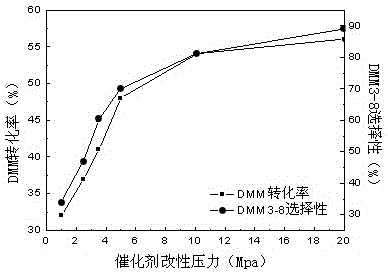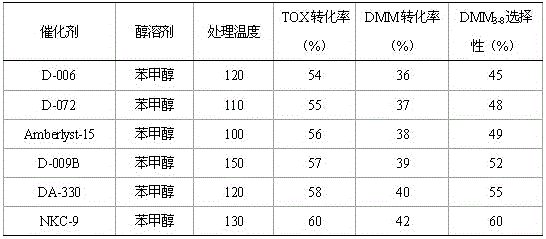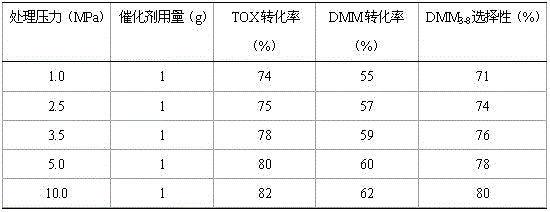Method for synthesizing sulfonic acid resin catalyst used for polyoxymethylene dimethyl ethers efficiently
A technology of polyoxymethylene dimethyl ether and sulfonic acid resin, applied in chemical instruments and methods, organic compound/hydride/coordination complex catalyst, catalyst activation/preparation, etc., can solve the problem of lower yield and non-recyclable Problems such as use, liquid acid catalyst and product are difficult to separate
- Summary
- Abstract
- Description
- Claims
- Application Information
AI Technical Summary
Problems solved by technology
Method used
Image
Examples
Embodiment 1
[0028] Put 3 grams of NKC-9 sulfonic acid tree catalyst into 100 mL containing insoluble alcohol solvent (methanol, ethanol, propanol, ethylene glycol, 1,3-propanediol, 2-propanol, n-butanol, n-pentanol , Isoamyl alcohol, n-hexanol, cyclohexanol, benzyl alcohol, etc.) in the reaction kettle, treat the sulfonic acid resin catalyst in the temperature range of 70-140 ℃ for 1-8h. The treated catalyst was filtered and dried in an oven at 120 °C for 6 h. The evaluation conditions of the catalyst were as follows: 60 mL of DMM, 20 g of paraformaldehyde, and 3 g of the modified sulfonic acid resin catalyst were weighed and added to the reaction kettle respectively. use N 2 Replace the air in the kettle three times under the condition of 1.0 MPa, so that the remaining air content in the kettle is lower than 0.1%. Into 2.0 MPa of N 2 , let it stand for 30 minutes, and use it for leak testing of the reactor to ensure that the device is airtight and then evacuate the gas in the reactor....
Embodiment 2
[0033] The polystyrene sulfonic acid resin catalyst (D-009B, DA-330, D-006, D-072, Amberlyst-15, NKC-9) of 3g different models is packed in the reactor containing benzyl alcohol solvent of 100mL, in 100-150 ℃, 5.0 MPa, under CO atmosphere for 1h. The treated catalyst was filtered and dried in an oven at 120 °C for 6 h. The catalyst evaluation conditions are as follows: Weigh 60 mL of DMM, 20 g of paraformaldehyde, and 3 g of modified sulfonic acid resin catalyst, and add them into the reaction kettle respectively. use N 2 Replace the air in the kettle three times under the condition of 1.0 MPa, so that the remaining air content in the kettle is lower than 0.1%. Into 2.0 MPa of N 2 , let it stand for 30 minutes, and use it for leak testing of the reactor to ensure that the device is airtight and then evacuate the gas in the reactor. Pass again 2.0 MPa N 2 , the stirring speed of the reactor was 500 rpm, the reaction temperature was controlled at 90 °C, and the reaction tim...
Embodiment 3
[0038] Put 3g of NKC-9 catalyst into a 100ml reaction kettle containing benzyl alcohol solvent, and treat it at 130°C, 5.0 MPa, and CO atmosphere for 0.5-20 h. After the treated catalyst was filtered, it was dried in an oven at 120 °C for 6 h. The evaluation conditions of the catalyst were as follows: 60 mL of DMM, 20 g of paraformaldehyde, and 3 g of the modified sulfonic acid resin catalyst were weighed and added to the reaction kettle respectively. use N 2 Replace the air in the kettle three times under the condition of 1.0 MPa, so that the remaining air content in the kettle is lower than 0.1%. N passing through 2.0 MPa 2 , let it stand for 30 minutes, and use it for leak testing of the reactor to ensure that the device is airtight and then evacuate the gas in the reactor. Pass again 2.0 MPaN 2 , the stirring speed of the reactor was 500 rpm, the reaction temperature was controlled at 90 °C, and the reaction time was 3 h.
[0039] Table 3. The effect of different cata...
PUM
 Login to View More
Login to View More Abstract
Description
Claims
Application Information
 Login to View More
Login to View More - R&D
- Intellectual Property
- Life Sciences
- Materials
- Tech Scout
- Unparalleled Data Quality
- Higher Quality Content
- 60% Fewer Hallucinations
Browse by: Latest US Patents, China's latest patents, Technical Efficacy Thesaurus, Application Domain, Technology Topic, Popular Technical Reports.
© 2025 PatSnap. All rights reserved.Legal|Privacy policy|Modern Slavery Act Transparency Statement|Sitemap|About US| Contact US: help@patsnap.com



